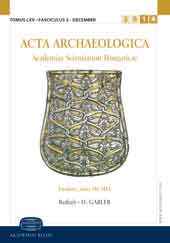Opfergrube der Hügelgräberkultur in der Gemarkung von Ménfőcsanak Spiralornament Auf Einem Tonfries Eines Gebäudes
Bothros of the Tumulus culture found at the state administrational boundary of Ménfőcsanak. Spiral decoration on the clay frieze of a building.
Author(s): Gábor IlonSubject(s): Archaeology
Published by: Akadémiai Kiadó
Keywords: Carpathian Basin; Koszider Period; building appliqué; spiral decoration; pithos; child sacrifice;
Summary/Abstract: Bothros of the Tumulus culture found at the state administrational boundary of Ménfőcsanak. Spiral decoration on the clay frieze of a building. The report focuses on only one feature of the preventive archaeological excavation performed on an area of 277,165 m2. In addition to the bones of cattle, domesticated pig, sheep and sheep/goat, as well as carp and pike in the pit, the skeleton of a child (aging between 5 and 8) identified as Inf. I/II was placed in a large bowl (pithos?). In addition to the fragments of two grinding stones with plant remains and phytoliths, as well as food remains and charcoal fragments referring to burning, and to many fractured vessels, such as storage vessels, dishes, knob-footed beaker, portable hearth (pyraunos?), the fragment of the clay frieze of a building was placed nearby the sacrificed child. The data processing by natural sciences was supplemented by two AMS 14C data. This feature can be dated to the second half of the Koszider Period. This report also describes the reconstruction of the building appliqué, the decoration motif of the clay plastic art, and its analogues, and particularly three transportation “corridors/routes”, through which this aesthetical innovation might have been exported.
Journal: Acta Archaeologica Academiae Scientiarum Hungaricae
- Issue Year: 65/2014
- Issue No: 1
- Page Range: 5-42
- Page Count: 38
- Language: German
- Content File-PDF

